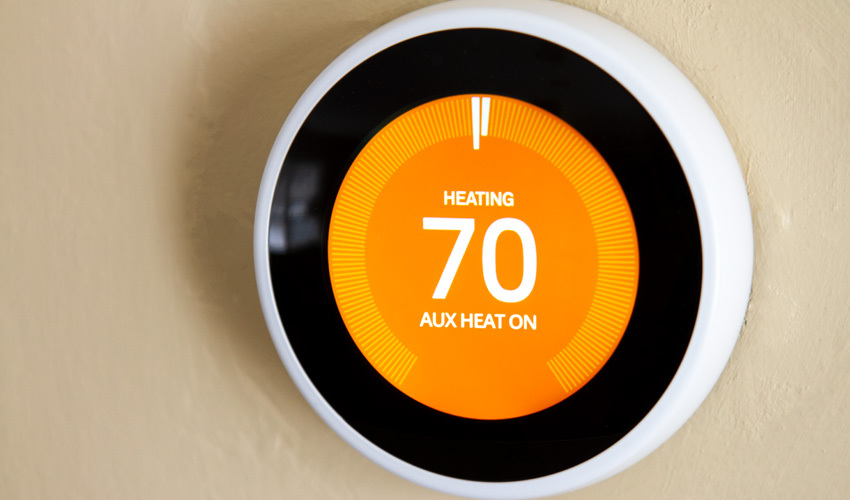What Does Aux Heat Mean on My Thermostat?

Most people do not know what “aux heat” means. It isn’t until it appears on a digital thermostat that they search for “What does aux heat mean on my thermostat?” While sometimes mistaken for emergency heat, aux heat is a heat pump setting on your thermostat. The term “aux” is short for auxiliary. Should your heat pump struggle to reach your desired temperature because of the extreme cold outside, the “aux heat” message shows that a secondary heat source (either gas or electric) has been deployed.
What Causes Auxiliary Heat To Turn On?
A home’s auxiliary heat typically kicks on automatically whenever the outdoor temperatures take a nosedive. Emergency heat must be manually turned on if your heat pump can’t keep up with heating demands. Since the heat pump is your home’s primary heating source, a secondary source may be needed if the weather gets too chilly.
What Temperature Should Aux Heat Come On?
There’s no specific temperature that the aux heat will activate. Instead, it will activate when one of the following occurs. First, aux heat on a thermostat activates when heat is unable to effectively move external air to the heat pump. This typically occurs when exterior temperatures hover around three to eight degrees (Fahrenheit) above freezing. In contrast, the interior temperature is approximately three degrees lower than what your thermostat is set at. Second, aux heat may come on when your heat pump is in defrost mode.
Why Does Aux Heat Stay On?
Aux heat turns on when the indoor thermostat struggles to reach and maintain the temperature setting. If your aux heat operates for an exceedingly long time, you may have an issue with your heat pump. Specifically, a faulty fan motor, bad compressor, or malfunctioning defrost control board may be to blame. You may ask, how do I stop my auxiliary heat from coming on? It’s harder to prevent than you might imagine. Instead of fighting an endless battle against your heating system, call on an HVAC professional for guidance.
What Does It Mean on My Thermostat?
Your aux heat indicator signifies that your heat pump needs some extra help reaching your desired temperature setting. When you see aux heat on the thermostat, you’ll know your heat pump is attempting to energize the auxiliary heat strip inside your secondary heating source. Essentially, if your heat pump is struggling to meet the desired temperature, aux heat turns on to give the pump an extra boost.
It’s up to your thermostat to determine when that auxiliary heat gets energized. As the temperature in your house drops a degree or two below the set temperature, the thermostat energizes auxiliary heat. The aux heat indicator on the thermostat displays a message to tell you when this is happening. Aux heat generally turns off once your home reaches your desired temperature.
How Do I Stop Auxiliary Heat From Coming On?
You might ask: how do I stop my auxiliary heat from coming on? Most thermostats won’t let you change the trigger point or disable auxiliary heat. Your best bet is to remove the aux wire from the thermostat or upgrade your thermostat to a different model. If you’re hoping to avoid these options, try to prevent your home’s temperature from dropping too quickly. Adding more insulation to your home and closing doors to rooms that aren’t in use can help. Regular maintenance of your HVAC unit can also keep the temperature in your preferred range.
How To Use Your Heat Pump Thermostat Settings in Cold Temperatures
Both geothermal heat pumps and air exchange pumps struggle to work efficiently in extreme temperatures. That’s because heat pumps must work extra hard to meet and maintain set temperatures. Aux heat will run more frequently in such situations, sending heating bills skyrocketing. During the coldest times of the year, it’s important to know how to fix aux heat on a thermostat. Here are a few tips for winter heat pump thermostat use:
- To avoid using aux heat, turn your thermostat up only two degrees at a time.
- Avoid turning on the emergency heat unless your heat pump breaks or another emergency occurs. Turning on emergency heat means relying on the secondary heat source, which tends to be a lot more expensive than aux heat.
- If aux heat is running even after outside temperatures reach 40 degrees or higher, it’s time to call a professional for help.
Contact Aire Serv® for Assistance
If you’re experiencing issues with aux heat on your thermostat, consult the experts at Aire Serv. Our team will identify the problem and provide solutions. Request an appointment online to get started.
 Click to call
Click to call


